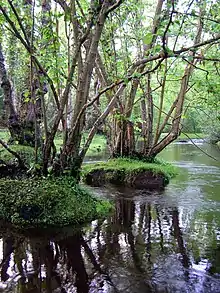River Dever
The River Dever /ˈdiːvər/ is a chalk stream in Hampshire in the south of England. It rises at West Stratton near Micheldever and flows westwards for 11 mi (18 km) to meet the River Test at Wherwell.[1]

.jpg.webp)
Course
The source is at 80 metres (260 ft) Above Ordnance Datum (AOD) alongside the A33, the main road north-east from Winchester, of Roman origin,[n 1] and meanders west through the village of Micheldever, three hamlets: Weston Colley, Stoke Charity and Wonston, then its largest village, Sutton Scotney, followed by Upper and Lower Bullington. The river skirts to the north of Barton Stacey and through the hamlet of Bransbury, meeting the Test on Bransbury Common, opposite the east fields of Wherwell on the multi-channel Test's West Bank at 48 metres (157 ft) AOD.[2]
Etymology
From Old English times some records have Myceldefer.[3] The likely first sound-meaning denoted by the scribe is /mixl/, that means "great", and the latter part, if from the Common Brittonic, "water, river" as in Andover or the Candover Brook nearby.[3]
Alternatively the Old Welsh /mixn/ for "bog" is suggested by the earliest-known form, from 862, Mycendefr, not relatively prevalent due to the gradient and alkaline water.[3]
Attributes
It is essentially fed by very close chalk aquifers, likewise to its continuation the Test, a highly abundant watercourse in Europe for large trout. It includes two trout farms, at the otherwise almost wholly green locality of Bransbury, and at Difford, north of Barton Stacey. The watermill at Weston Colley is a Grade II listed building/.[4] The mill at Bransbury is also Grade II listed.[5]
Water quality
The Environment Agency measures the water quality of the river systems in England. Each is given an overall ecological status, which may be one of five levels: high, good, moderate, poor and bad. There are several components that are used to determine this, including biological status, which looks at the quantity and varieties of invertebrates, angiosperms and fish. Chemical status, which compares the concentrations of various chemicals against known safe concentrations, is rated good or fail.[6]
Water quality of the River Dever in 2019:
| Section | Ecological Status | Chemical Status | Overall Status | Length | Catchment | Channel |
|---|---|---|---|---|---|---|
| Dever[7] | Good | Fail | Moderate | 20.181 km (12.540 mi) | 128.005 km2 (49.423 sq mi) |
References
- References
- Ordnance Survey (1995). OS Landranger Map 185 - Winchester and Basingstoke. ISBN 0-319-22185-7.
- "Elevation Finder".
- Eilert Ekwall (1928). English River Names. OUP. pp. 290–291.
- Historic England (16 November 1983). "Old Mill Cottage (Grade II) (1350775)". National Heritage List for England.
- Historic England (21 May 1984). "Bransbury Mill (Grade II) (1093471)". National Heritage List for England.
- "Glossary (see Biological quality element; Chemical status; and Ecological status)". Catchment Data Explorer. Environment Agency. 17 February 2016.
 Text was copied from this source, which is available under an Open Government Licence v3.0. © Crown copyright.
Text was copied from this source, which is available under an Open Government Licence v3.0. © Crown copyright. - "Dever". Catchment Data Explorer. Environment Agency.
- Notes
- Part of the road from Silchester to Winchester, Margary route 42A, at around grid reference SU535402
